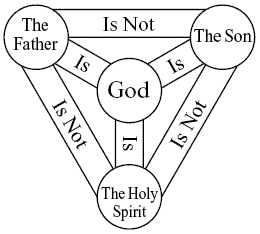The Pattern of three that is being used is often called the dialectic, popularized by Plato, Hegel, Marx and others. The operation is most universally stated in the abstract:
Thesis -> Antithesis -> Synthesis
Since the interaction of God necessarily has no end or beginning, any starting point will have an endless regress. But we must start somewhere.
1
Son -> Father -> Holy Spirit
A very early issue in the church was over modalism and trithesim. Each was an attempt at reconciling the doctrine of the trinity into something that made practical sense.Son -> Father -> Holy Spirit
Modalism claimed that the father/son/spirit are modes of being that occur in series, so god can only be one at a time. This diminished the whole, as the other two would only be able to operate in the background one at a time. This would keep the divine within the temporal, and thus contradict the requirement of omnipresence.
Tritheism takes very literally that the persons of God are separate persons who are three different gods. Three in parallel. This contradicts the requirement of omnipotence because each god would have a third of the whole, dividing their power.
This is just like series and parallel circuits in electronics. They dissipate, but cannot amplify. For that, you need something more.
The historical resolution of these two incompatible views was the Athanasian Creed which kept the Trinity in an abstract balance of associations.
Is and Is-Not are all we get out of reading this literally
The more abstract diagram here does tell us something, but not what the god-symbols are doing. In order for it to make sense, we have to think of how they interact. In the books of the gospel, you see Jesus communicating variously as god, or as an ordinary man. After he overcomes temptation, he begins his ministry, and the holy spirit shows up externally as a dove. Eventually he becomes one with god during prayer and he is transfigured into something new, fully integrating the holy spirit. The holy spirit is the living relationship between god and man.
2
Church -> Christ -> Heaven
Church -> Christ -> Heaven
The universal church is another central theme in Christianity. The church is symbolized as a woman in artwork, and rightly so. The church is the symbol of the whole sanctified world. The mother of god, and much like the trinity, is little understood. The same pattern used above to reconcile father, son, and spirit can now be used to reconcile Christ, the church, and heaven. A major theme in the bible is the effort of God to move the chosen people from harmful government and superstition, to create a new system. This plays out gradually. An example is in Israel's exodus from Egypt, and the time of the judges. Israel rejected the priestly judgments of Samuel and demanded a secular king, so they got Saul. In the new testament, Jesus reconciled this divide by becoming the King/High Priest, but not of the civil government, and not of the Pharisee's religion. He declared that the kingdom is at hand, and all are welcome to follow him. His actions emphasize overcoming the rule of government, religion, and ego, in order to become free to practice good behaviors autonomously.
This is not only an individual call, but a collective one. For the group; the church to become free of government and religion. Once free, they may apply the principles of government and religion under the guidance of Spirit. This is seen played out in the book of Acts. The early church forms an autonomous collective, gathering and redistributing their wealth. This is violently suppressed by Rome, and becomes a subversive theme in Christianity from there on out.

This is not only an individual call, but a collective one. For the group; the church to become free of government and religion. Once free, they may apply the principles of government and religion under the guidance of Spirit. This is seen played out in the book of Acts. The early church forms an autonomous collective, gathering and redistributing their wealth. This is violently suppressed by Rome, and becomes a subversive theme in Christianity from there on out.
3
Id -> Superego -> Self
This pattern finally comes back to the personal realm. This also resembles the actions of the theory of the bicameral mind. What is interesting is that the ego is not part of the pattern. The ego is a fixation of personality upon either the id or superego, we can define the ego as only-self-love. When we snip out the ego we can see the pattern clearly. The Id, or instinctual-mind, first asserts itself in life. Soon the superego, or idea-forming-mind, begins to dictate instructions often contrary to the desires of the instinctual-mind. Paradox and contradiction ensue! The mind displays cognitive dissonance until eventually the two reconcile, and the ego fixation dissipates. What remains is a clearer sense of self.
4
Child -> Parent -> Grandparent
The
resolution of the child/parent with the grand-parental
relationship symbolizes the reconciliation of the child with the
parent as they both reach their next stages of growth. Grandparents symbolize the spirit of ancestral wisdom. It is this very pattern of
relationship that maintains the link of one generation to the next.
Father and Son reunited allow the Holy Spirit to flow in. It is the
circle of life.

Wisdom -> Love -> Spirit
Father -> Mother -> Child
Self -> Neighbor -> Community


No comments:
Post a Comment